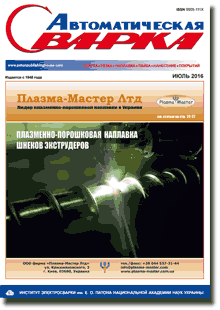| 2016 №07 (05) |
DOI of Article 10.15407/as2016.07.06 |
2016 №07 (07) |

Avtomaticheskaya Svarka (Automatic Welding), #7, 2016, pp. 35-40
Control of mechanical properties of high-strength steels through optimized welding processes
M. Fiedler, A. Plozner, B. Rutzinger and W. Scherleitner
Fronius International GmbH, 1 Froniusplaz, А-4600, Wels, Austria. E-mail: Scherleitner.Wolfgang@fronius.com
Abstract
Time of cooling in the range from 800 to 500 °C is a crucial factor, which determines the properties of welded joints of high-strength steels significantly. In field welding the cooling time t8/5 can be steered by the heat input even at different wall thickness of the base materials used. Modern arc processes with reduced heat input allow, at the same deposition rates, increasing the stability of strength level due to optimized equipment settings. This paper compares the influence of conventional GMAW processes, like short-arc, pulsed-arc ones and new launched processes, on properties of the weld. From this point of view practical conclusions and recommendations can be derived to optimize weld properties. 5 Ref., 5 Figures, 5 Tables.
Keywords: arc welding, high-strength steels, heat input, weld properties
Received: 17.03.16
Published: 02.08.16
References
- Matthes, K.-J., Richter, E. (2008) Schwei?technik Schwei?en von metallischen Konstruktionswerkstoffen.
- Artelsmair, J., Bruckner, J., Kazmaier, J. Der CMT-Prozess — Ein neuer Prozess in der Fugetechnik.
- Ro?mann, F.-J. Neue Impulse fur kontrolliertes und schnelles Schwei?en.
- Rutzinger, B. Influence of the welding process to the dilution rate, of weld overlays on unalloyed steel using the weld consumable ERNiCrMo3 (Alloy 625).
- Fiedler, M., Rauch, R., Schnitzer, R. et al. Alform welding system — the world’s first system for high-strength welded structures. In: of 68th IIW Ann. Assembly & Int. Conf. (Helsinki).
